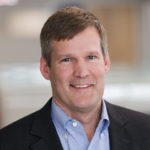Examining Amplifier Leadership: Tim Hassinger
Below, we’re examining a profile of Amplifier leadership and followership from Clarkston CEO Tom Finegan’s new book – Amplifiers: How Great Leaders Magnify the Power of Teams, Increase the Impact of Organization and Turn Up the Volume on Positive Change. To learn more about Amplifiers and order the book, click here.
Thirty years ago, as I was busy creating our consulting firm at the front end of my own career, I was assigned to a project helping to integrate a massive joint venture between two of the largest global agricultural chemical companies. It was a massive project in scope, but we really didn’t have a massive team to complete the work. I found myself working with all of the key executives across the newly formed entity and across all of the core business functions, with the exception of R&D. Although a deep subject matter expert, I did not have the crop science background and, in that regard, was a bit over my skis. To be successful, I needed to invest my personal time to learn the business. Luckily for me, a number of the mid-level client leaders on this transformation project were subject matter experts in their individual area but were never really exposed to how all the pieces of the puzzle fit together. This enabled us to invest in each other, as they explained the business to me, and I explained how other pieces of the puzzle needed to fit together in order for the transformation and optimization of the newly formed joint venture to succeed.
Amplifiers Out Now: Order Here
The integration effort was massive in scale, yet the team assigned to it was quite modest. There were two dozen employees assigned from the client who were supplemented by a few consultants from our firm. It is in this backdrop where I first met Tim Hassinger. There is no way that we were going to be able to get the project done with such a small team given the massive functional and global scope, unless we enlisted a key person strategy, whereby we identified key Amplifiers (although we did not know that was the profile at the time) who could understand the vision and carry out our vision while leading others along. At the time, this struck me as simply getting the leader on board and executing on the common change management approach of key person strategy or change agent. I was only partially right. Fortunately for me, the executives at the company clearly understood and made conscious decisions surrounding this strategy. They knew that our mission was big, and our resources were limited.
Amplifier Leadership Amidst a Joint Venture
Mergers, acquisitions, divestitures, or joint ventures happen for a variety of reasons. This particular joint venture was done as the minority partner wanted to focus their effort on their pharmaceutical business and the majority partner wanted to layer in the commercial product line and intellectual property, global market access and commercial customer base, and manufacturing capability, all while leveraging synergies in the combined entity. Hassinger was an up-and-comer and relatively new in his career. He was assigned to work in the supply chain area, ultimately reporting to the vice president, Jim Theis. Theis was a hard-nosed and demanding executive. I remember getting particularly nervous when I would need to go meet with him, since he was always a bit skeptical about consultants. He had high expectations and was a highly demanding manager, even more so for consultants. I knew I needed to be on my game when I met with Theis. Fortunately, we both know that we needed from each other in order for us both to deliver on what was promised in the joint venture integration. He also knew that I could play a valuable role in the development of his key leadership development candidates.
Theis described his vision for what he expected out of the joint venture and the efficiencies he saw across the supply chain, working capital, and customer service levels. Planning in the seasonal agricultural business is particularly challenging, especially with the technology tools we had at the time. It was in one of my meetings with Theis where he explained how they rotated their high potential employees through certain roles in the company and that I would benefit from learning from Hassinger, and he would benefit from learning from me. He emphasized to me that Hassinger’s peers would look to see how he adopted the changes that we were making and if Hassinger was on board, they’d soon join him.
Standout Amplifier Leadership and Followership: Tim Hassinger
What I’ve learned over the years working with hundreds of companies and thousands of these change agents is that Hassinger’s followership skills were clearly at play here. He was a true Amplifier, that kind of employee that combines leadership and followership into a single package. Like electricity needs AC and DC currents, Amplifiers need both leadership and followership currents. From another leader, Hassinger learned a valuable lesson on bringing a team together. Leading and managing a function is very different than leading and managing a team. Team selection, onboarding, and motivating are all essential elements to get the desired outcomes the team was brought together to achieve.
Hassinger also learned how to be a global thinker from another of his mentors. In order for leaders to ascend in their careers they need to be exposed on a global basis. This may seem difficult before being assigned in market but again, Hassinger was methodically exposed to solve global problems and be in market meetings with key stakeholders. Developing the global Amplifier leadership mindset is not just understanding the particular regulatory and market nuances, it is essential that the cultural aspects are incorporated into the thinking and development. He would also take interest in my personal acclamation in these global situations. His mentor for global thinking lasted far beyond his global assignments and responsibilities, but frequent touch points on issues existed long after the assignment.
Amplifiers Out Now: Order Here
Hassinger spent three decades with increasing levels of responsibility and leadership within the same company ultimately becoming the CEO of a major division. This led him to being recruited and accepting the CEO position of a publicly traded company. Joining a new company after such a long tenure at the previous employer provided new opportunities for learning and growth. He no longer knew the large numbers of employees who worked for him, nor had deep institutional knowledge of the culture and how change would need to occur. He knew he needed to learn these dynamics and learn quick. Likewise, the organization itself needed to come to terms with the fact that a new outside CEO was here to affect change and set a new direction for the company.
In this situation, Hassinger was immediately placed in a position where the answer to the question “Are people following me because of my role or my influence?” is clear. For new leaders appointed from the outside, the initial set of followers are following because of position power. The challenge then becomes how to quickly gain influence throughout the organization and how to determine the composition of followers on staff. It’s natural in a leadership transition for many alienated follower holdovers to leave. Also, many pragmatist followers will leave with a leadership change at the top, especially one where stated change is necessary, which undermines the very safety that pragmatist followers require. The exemplary followers under the previous leadership likely have loyalty to each other, the organization, or the mission. However, these exemplary followers will quickly size up the new leader to determine whether or not they will follow them.
Bringing in New Leaders
An old mentor of mine once told me that God gave me two eyes, two ears, and one mouth for a reason — to observe and listen twice as much as I should speak. This advice has served me well over the years. It is especially important when a new outside leader is assigned. New outside leaders are brought in for a reason. The senior leaders or boards of directors bring in outside leadership to solve a particular problem or fill a particular void. Having a game plan for determining the composition of your follower workforce is essential for the new leader’s success.
One of the key things the new leader does while formulating his transformation strategy, is to watch and observe and listen to what his key lieutenants are doing and saying. The leader may hear a lot of “yeah buts,” or “you need to understand” as they formulate the new plans and strategies. It’s important to fully understand the environment in which the strategy needs to be deployed. But if the same lieutenants are uttering the same pessimistic phrases, it’s likely they won’t last. It’s harder to understand the composition of the employee base at the next level down. Hassinger held a series of smaller team meetings with the direct reports of his key lieutenants, without the key lieutenants present, in order to yield important insight into the company. All throughout these activities the leader is both gaining insights but, equally as important, starting to build trust among the employees throughout the organization.
In other cases, leaders make themselves available on various smaller scale forums. Who they interact with across the functional areas of the business, how accessible they make themselves in the office or when they go on-site to remote facilities, or open Zoom calls, often speaks volumes to their trust building and insight gathering among employees.
One of the most effective things that happened to Hassinger as he was assimilating into his new role as the first outside CEO of the publicly traded company happened by accident at a dinner given by an outside third party. They gave the participants the chance to ask Hassinger any question. One question came in, “You send me emails on Saturday. Do you expect me to work the weekends?” Having a real, open, and safe environment is critical. Hassinger was new to the company, the culture, and its people. He forgot the people were not just listening to his words but were watching his actions. Over the years, he was in tune with his own personal work style and how and when he was most productive. His kids were grown up and he no longer had the Saturday morning responsibilities of a young parent. He quickly said that his style was when he had ideas, he would jot them down and send the note. Hassinger emphasized that he did not expect responses over the weekend, but if he did, he would clearly put that in the note. This experience not only reinforced the need for him to communicate his working style and expectations of them, but also help to get them established as individuals and personalized his style with them.
Amplifiers Out Now: Order Here
Tim Hassinger is a standout profile of Amplifier leadership and followership. To learn more about what the Amplifier mindset can do for your organization, order a copy Amplifiers or visit the Amplifiers site to learn more. Amplifiers is out now! You can purchase a copy on Amazon, Barnes and Noble, Books A Million, or Bookshop. Also, you can read Tom’s story of why he wrote Amplifiers here.
Subscribe to Clarkston's Insights



